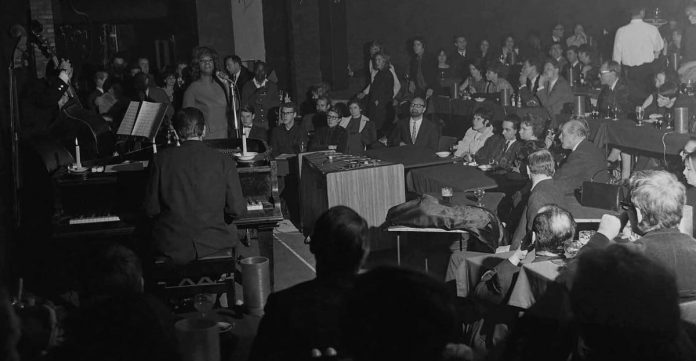
Ronnie Scott was, as someone once put it, a very interesting bunch of guys and Oliver Murray has got together a very interesting bunch of guys to build a composite portrait of a great British institution. Its problem, of course, is that it rapidly became an institution, and as someone (this time it was Oscar Wilde, speaking of marriage) said, not everyone wants to live in an institution.
The evolution of Ronnie Scott’s from an edgy, artist-led music club to destination venue was nobody’s fault; indeed, an almost inevitable by-product of Ronnie’s (and Pete King’s) unswerving devotion to the club. In its heyday, it was one of the world’s great jazz spots, easily sitting up there with the Village Vanguard, the Jazzhus Montmartre, Keystone Korner and the Lighthouse, but the place to be at Ronnie’s was never at a little lamped table or within sweat-flying distance of Oscar Peterson or Dizzy Gillespie, but in the boss’s office, where he held court in whichever of his personalities was appropriate to the moment.
The only problem with Oliver Murray’s superb account is an apostrophe, for this really is a portrait of Ronnie Scott himself, inevitably punctuated by priceless archive footage of everyone from Sonny Rollins to Sarah Vaughan, Jimi Hendrix to Nina Simone (they actually managed to get some footage of her actually at the club), Miles Davis to Mary Lou Williams, countless others. And yet, the most startling musical moment of the film comes from Ronnie himself, near the beginning, with Tony Oxley behind proving that he was, indeed, one of the top three time drummers of the era. Everyone knows Ronnie Scott. Everyone has a favourite Ronnie Scott joke, and humour was his strongest defence against the world. But he remains catastrophically underrated among British, European, world saxophone players.
His childhood, as it emerges here, was dark. Joseph Schatt features only shadowily; Ronnie’s mother Sylvia was devout. Functionally fatherless, but for the knowledge that he had been sired by a saxophone player, Ronnie grew up in a Whitechapel still largely associated in the national mind with Jack the Ripper, another “bunch of guys” who never quite got tracked down. The childhood was poor and the first and best of the Scott jokes in the film (only spoiler) is about how as a kid he’d been dressed out of the War Surplus store. We are asked to imagine how it must have felt as a small boy to have to go to school wearing a Japanese admiral’s uniform.
Watch his body language, or at least the facial expression, that goes with the gag and you will see that unlike a Billy Connolly, who tells similar stories to hide pain, Scott told them to hide himself. The pay off is accompanied by the click of a facial lock. It’s Michael Parkinson, still being gazetted as a talking head on jazz, who first mentions the darkness of Scott’s personality but it’s hard to get away from and its eventual outcome always seems to hover in the background.
The film will be cherished, almost certainly, for the richness of its archive material. It’s clear that musicians – well, maybe not Miles Davis – enjoyed playing there. It’s not insignificant that the first sounds we hear, over a dark screen, are instructions to the audience not to take photos and to turn their phones off. Even before that, there’s the self-congratulatory chatter (“we’re at Ronnie’s!”) that has always been a feature of the place, inspiration for the “are we playing too loud for you?” line that was at least once, to my certain knowledge, answered in the affirmative.
There are probably two films here, each striving with the other. Both are equally fascinating but the they feel like Chang and Eng.















